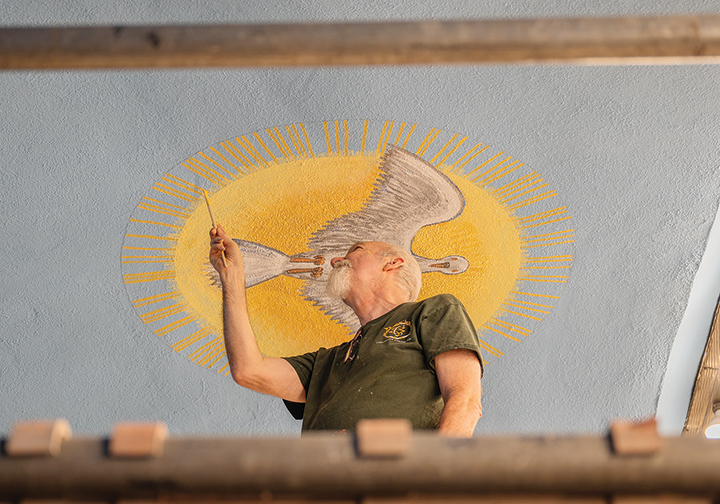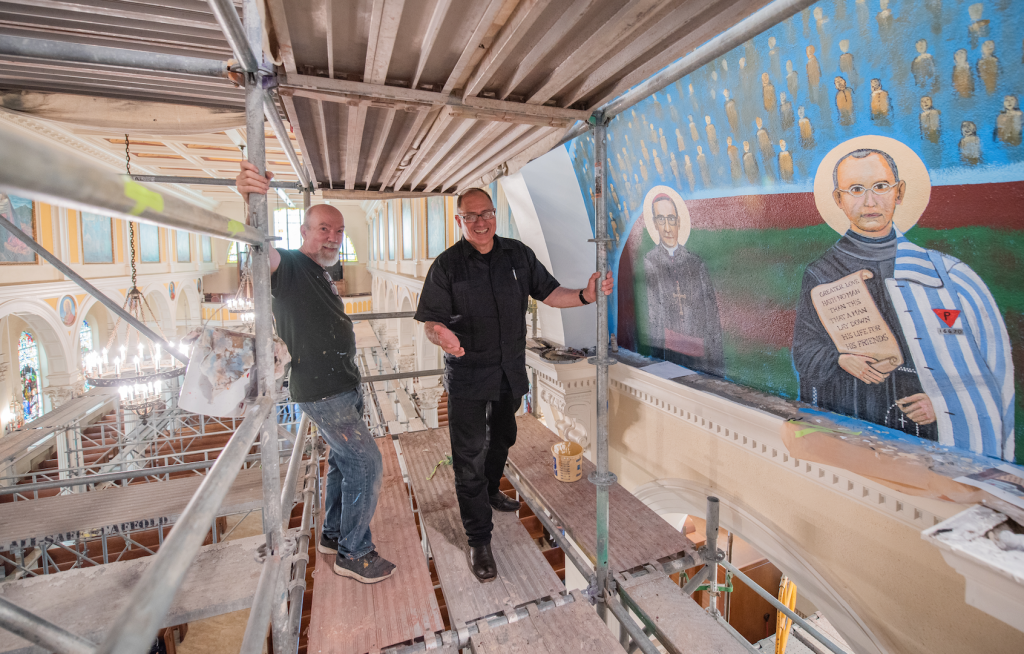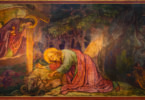
by Joe Bollig
joe.bollig@theleaven.org
KANSAS CITY, Kan. — There’s a thrilling scene in the Book of Revelation where St. John recounts a marvelous sight of the saints in heaven:
“After this I had a vision of a great multitude, which no one could count, from every nation, race, people and tongue. They stood before the throne and before the Lamb, wearing white robes and holding palm branches in their hands” (7:9).
Parishioners at All Saints Church in Kansas City, Kansas, will see their own version of St. John’s vision around July 10 when the scaffolding comes down and the results of their church interior painting project will be revealed in all its glory. The project began on April 1.

Before, the walls and ceiling were a stark, bare white. Now, parts of the church have been brightened by rich hues, including metallic gold, burgundy and blue.
The square spaces of the nave’s ceiling, from choir loft to apse, have been filled with large, stylized dogwood flowers. The ceiling of the apse depicts, on a blue background, a multitude of the saints in heaven with 12 saints standing out large in front of the multitude. Above them all hovers the Holy Spirit.
Twelve saints were chosen for special treatment because they are the saints for whom the local community has particular devotion, said pastor of All Saints and St. Mary-St. Anthony parishes Father Peter Jaramillo, SSA. They reflect the richness of the history and present ethnic diversity of what had been known as “Polish Hill” for much of the 20th century.
Originally, it was St. Joseph Church, built by Polish immigrants. The new name came about after a series of parish consolidations.
The saints who dominate the apse ceiling are Sts. Cyril and Methodius, St. Teresa of Kolkata, St. John Paul II, St. Kateri Tekakwitha, St. Benedict, St. Faustina Kowalska, St. Juan Diego, St. Maximilian Kolbe, St. Oscar Romero, St. Josephine Bakhita and St. Jose Luis Sanchez del Rio.

The century-old church needed some cleaning and a makeover, but that wasn’t the only reason for the project, said Father Peter.
“It happened out of a desire for cleaning and renewing our church after the pandemic, an opportunity to integrate people back into the community after all the struggles and depression of the pandemic,” he said. “There were also spiritual concerns and people leaving and not coming back.
“So, we came up with a plan to renew the spirit, and part of the renewal of the spirit was to bring back a welcoming community by cleaning up the church. It’s a beautiful church and always has been. It needed some attention.”

Fortunately, the parish had unused beautification funds. These and additional funds raised by parishioners “buying” a dogwood flower or saint paid for the approximately $190,000 cost.
For the project, Father Peter turned to two men who did a previous job at St. Mary-St. Anthony Parish. They are Paul Helmer, architect and color consultant with Touch of Distinction Color and Design of Kansas City, Missouri, and Phelipe Linstrom of Linstrom Pro Painters of Sugar Creek, Missouri. Other team members are Peyton Alexander and Danny Bardwell.
This would be the third project that Helmer and Linstrom have done together.
“The church is of singular beauty with all this great architecture,” said Helmer, a member of Guardian Angels Parish in Kansas City, Missouri. “The interior is pretty spectacular.
“We decided that, to do the ceiling, we picked colors that were already on the side walls. Blue is a predominant color. Burgundy, and all the colors we used, are liturgical colors.”

The dogwood flower design of the nave ceiling was chosen for its spiritual significance. There is a legend that dogwood was used for the cross of Christ. Jesus, sensing the tree’s distress, transformed the dogwood species so it would never again be used for crucifixion.
In addition to the saints in the apse and the nave ceiling, Helmer and Linstrom are painting the walls behind the side altars and the reredos (back) of the pre-Vatican II high altar, for greater contrast and beauty. Tarnished filigree on the high altar and reredos were regilded to give them a warm, gold-colored hue as when they were new.
“Father Peter has been the leader of this project,” said Linstrom, who is Lutheran.
“When you’re doing something like this, there are a lot of emotions involved,” said Linstrom. “There are a lot of people who have opinions about what needs to happen, and it’s difficult to make those compromises so it will work for everyone.
“God bless Father Peter and his leadership. He visits us daily and he’s always blessing us and praying for our ability to do God’s work here. If it were not for his support, it couldn’t have happened. He’s been behind our spiritual journey to make this project happen.”

This part is phase one, said Father Peter. The parish will do phase two — painting the rest of the church — when sufficient funds have been raised.
“The joy of this for a pastor is creating something beautiful,” he continued. “So many times we have to put the money of parishioners into things like retaining walls, sewer lines, furnaces and boilers. Rarely do you get an opportunity to do something like this.
“My hope is as we beautify the Church of All Saints it will bring about a revival of people wanting to support our parish.”
“We live in a generally poorer community,” added Father Peter, “but we can have beauty. We can enjoy the splendor of these old churches that express such beauty and love of the tradition of the faith. These local immigrant churches contain so much history and splendor of art that speaks to the soul.”







St. Joseph-St. Benedict church was always beautiful. So much history there for me. I was class of 1989. Would love to come back and see it in person.
Thank you for the pictures and article.